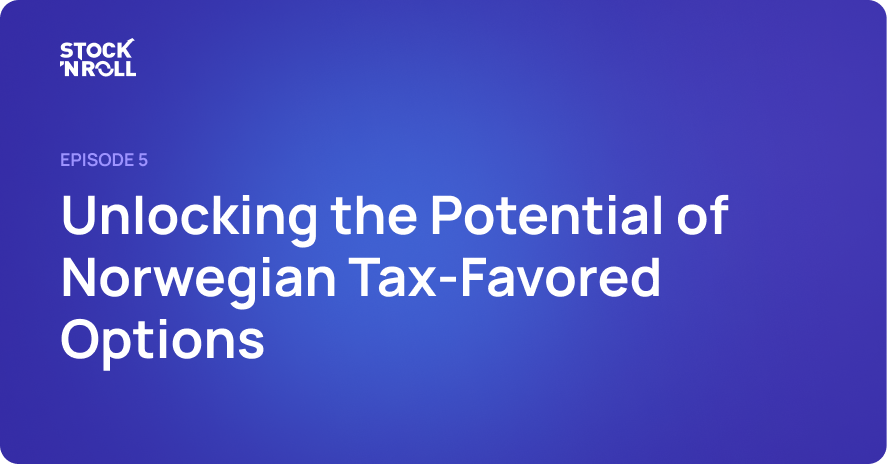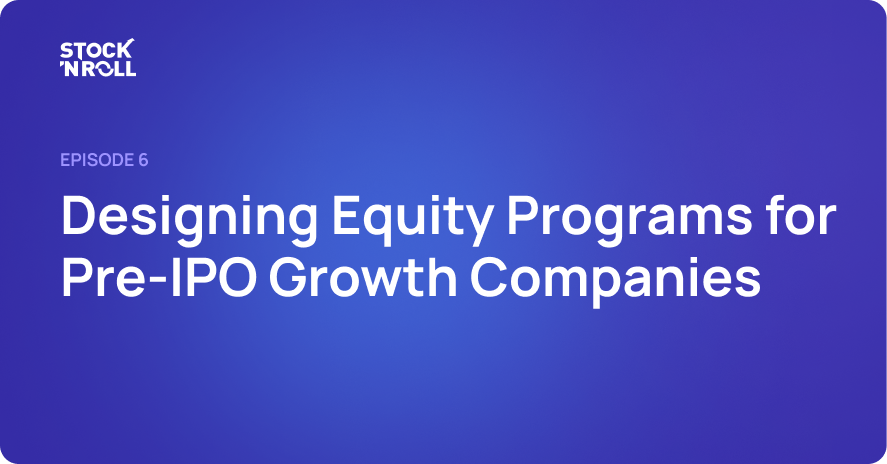Equity compensation is a cornerstone of incentivizing employees, especially in startups where liquidity is often scarce. In the latest episode of Stock 'N Roll, we sat down with tax law expert Sverre Hveding to discuss share incentive schemes in Norway, focusing on the recently updated tax-favored options program.
For startups and growth companies, structuring a compelling and tax-efficient incentive plan is crucial to attracting and retaining talent. Below, we break down the key takeaways from our conversation with Sverre, and an overview of the recent regulatory changes that make tax-favored options more accessible than ever.
Why Share-Based Incentives Matter for Startups
Unlike listed companies, startups face unique challenges in offering equity incentives:
- Limited Cash Flow: Bonuses are often not viable due to constrained capital.
- No Liquid Market: Unlisted shares are illiquid, making it hard for employees to sell and realize value.
- High Risk: Employees taking equity in a startup accept significant risk.
- Valuation Complexity: Determining the fair market value of shares is more challenging in private companies.
Given these challenges, properly structured equity compensation plans are vital to ensuring incentives align with both company and employee interests.
Understanding Norway’s Tax-Favored Options
In response to liquidity and tax burdens associated with traditional stock options, Norway introduced a tax-favored options scheme. This allows employees to defer taxation until they sell their shares, instead of triggering tax at the time of exercise. Moreover, gains are taxed as capital income rather than salary, significantly reducing the tax burden.
Key benefits of tax-favored options:
- No tax at grant
- No tax at vesting
- No tax at exercise
- Tax is only due upon sale of shares, and at the favorable capital gains tax rate (currently 38% instead of up to 47.6% salary tax)
New Entry Criteria for Tax-Favored Options (Effective March 2025)
A recent regulatory update significantly expands the eligibility criteria for Norwegian startups to use this tax-favored scheme. Below is a comparison of the old and new criteria:
| Criteria |
Previous Rules |
Updated Rules (March 2025) |
| Max. Employees |
80 |
150 |
| Max. Balance Sheet (MNOK) | 80 | 200 |
| Max. Revenue (MNOK) | 80 | 80 |
| Max. Company Age (Years) | 10 | 12 |
This expansion allows more growth-stage companies to take advantage of the tax benefits, particularly those scaling rapidly but still considered startups.
Alternative Share-Based Incentives
For companies that do not qualify for tax-favored options or prefer other models, there are additional equity incentive structures, including:
- Share Purchase Programs – Employees buy shares at fair market value, benefiting from capital gains tax treatment but requiring an upfront investment.
- Regular Stock Options – Traditional options can be used but create tax liability upon exercise, leading to potential liquidity challenges.
- Kyrus-Smith Model – A structured share purchase where employees invest a small amount upfront with deferred payments upon exit.
However, these alternatives come with their own tax and liquidity considerations, making the new tax-favored options an attractive choice whenever eligibility permits.
Implementation & Best Practices
To ensure a successful equity incentive plan, companies should:
- Define scope and allocation (e.g., % of shares reserved for options).
- Establish clear eligibility criteria and vesting schedules.
- Obtain board and shareholder approval to legally authorize the plan.
- Structure agreements carefully, ensuring flexibility in case of corporate transactions or regulatory changes.
- Communicate the program effectively to employees to maximize its motivational impact.
Conclusion
The recent expansion of Norway’s tax-favored options scheme marks a significant step forward for startups looking to attract and retain top talent. By deferring taxation and offering capital gains treatment, these options create a more attractive and financially viable equity compensation model.
For startups navigating share-based incentives, it’s crucial to consider both regulatory constraints and strategic design choices. If you’re exploring equity plans for your employees, understanding the latest changes and structuring your incentives properly can make all the difference.
Click here to read the article published by Sverre Hveding and Remi Christoffer Dramstad on Selmer's website.


Interested in being a guest or do you know someone that would be?
Subscribe below and follow us on social media to stay updated with our insightful blog posts. We're here to help you navigate the world of equity incentives and drive your company's success!


